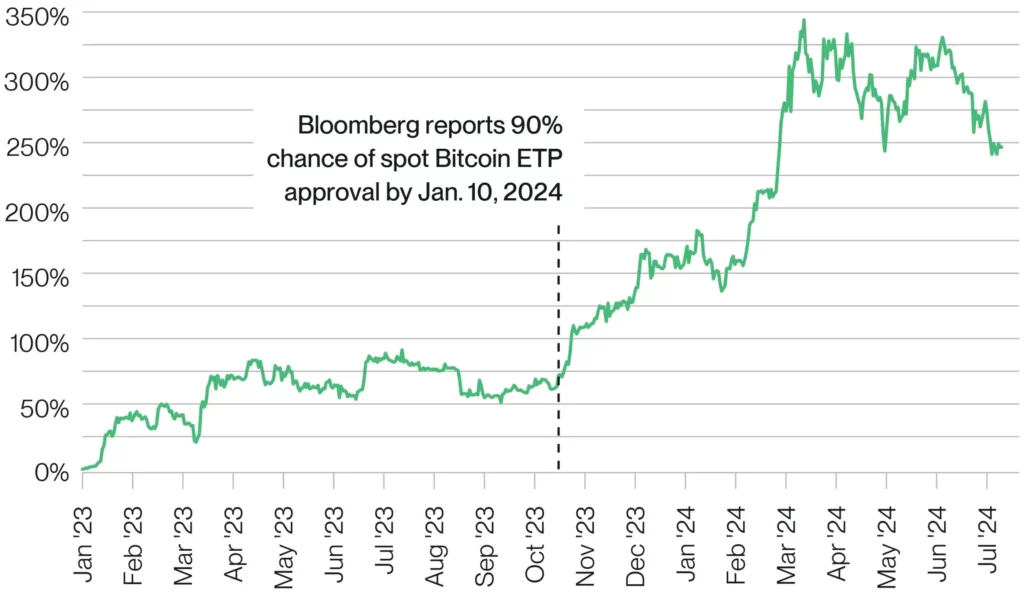Bitwise CIO: ETFs’ Impact on Ethereum Will Surpass Bitcoin
Everyone wants to know what will happen to Ethereum’s price after the launch of spot ETPs (Note: ETFs are a type of ETP). My prediction is that the inflow of funds into Ethereum ETPs will drive the price to an all-time high, exceeding $5,000.
Of course, this won’t happen immediately. I believe ETH might experience some volatility in the first few weeks, as the $11 billion Grayscale Ethereum Trust (ETHE) converts to ETP and funds flow out. But I am confident that Ethereum will hit a new high by the end of the year. If the inflows exceed expectations, Ethereum’s price could be even higher.
Supply and Demand Determine Everything
The best way to estimate the potential impact of ETP issuance on Ethereum’s price is to analyze supply and demand. ETPs don’t change Ethereum’s fundamentals, but they do introduce new sources of demand.
Consider the price change of Bitcoin after the launch of spot Bitcoin ETPs in January. Since that day, the number of Bitcoins bought by ETPs has been more than double the number of Bitcoins produced by miners:
- Bitcoins bought by ETPs: 263,965
- Bitcoins produced by miners: 129,181
As a result, Bitcoin’s price increased. Since the launch of the Bitcoin ETP on January 11, Bitcoin has risen by about 25%. If we count from October 2023, when the market began pricing in the Bitcoin ETP, Bitcoin has risen by over 110%.

Will we see the same impact on Ethereum? Yes, I think the impact could be even greater.
As I’ve written before, I believe the new Ethereum ETP will attract billions of dollars, and the funds flowing into these new ETPs will have a more significant impact than on Bitcoin for three reasons.
Reason 1: ETH’s Lower Short-Term Inflation Rate
When the Bitcoin ETP launched, the Bitcoin network’s inflation rate was 1.7%. In other words, the Bitcoin network produced about 328,500 BTC per year, worth approximately $16 billion at that time. This means we needed $16 billion of Bitcoin purchases per year to maintain its price.
In contrast, Ethereum’s inflation rate over the past year was precisely 0%: there were 120 million ETH a year ago, and there are still 120 million ETH today. This is because, although a small amount of ETH is generated daily, users consume ETH using applications on Ethereum, from stablecoins to tokenized funds. Over the past year, these forces have balanced out.
A large influx of new demand meets 0% new supply? Moreover, if activity on Ethereum increases, the consumption of ETH will also increase, which is another organic demand lever favorable to investors.
Reason 2: Unlike Bitcoin Miners, Ethereum Stakers Don’t Need to Sell
The second major difference is that Bitcoin miners typically have to sell the Bitcoin they produce, whereas Ethereum stakers do not.
Bitcoin mining is costly, requiring high-end computer chips and significant energy consumption. Therefore, miners typically sell most of the Bitcoin they mine to cover operating costs.
Ethereum, however, does not rely on mining. Instead, it uses a system called “proof of stake.” In proof of stake, users stake ETH as collateral to ensure they accurately and honestly process transactions. As a reward for processing transactions correctly, stakers receive new ETH.
A key difference between Bitcoin mining and Ethereum staking is that staking does not have significant direct costs. Therefore, Ethereum stakers are not forced to sell the ETH they earn. Even if Ethereum’s inflation rate rises above 0%, I do not believe stakers will face significant selling pressure.
In the short term, the daily forced selling pressure on Ethereum is significantly less than on Bitcoin.
Reason 3: 28% of ETH is Staked and Cannot Enter the Market
Staking also has another impact: when you stake ETH, you lock it up for a period. During this time, you cannot withdraw and sell it. Currently, 28% of all ETH is staked, which means it is effectively out of the market.
Additionally, another 13% of ETH is locked in decentralized finance smart contracts, such as collateral in lending markets. This further reduces the amount of ETH available on the market.
Altogether, approximately 40% of ETH is partially or entirely out of the market.
What Does This Mean?
As mentioned above, I expect the new Ethereum ETP to be successful, attracting $15 billion in new funds within the first 18 months of its listing. Ethereum is currently trading at around $3,400, just 29% below its all-time high. If the ETP is as successful as I anticipate, it is almost certain that Ethereum will reach a new high.